Top Coffee Producing Countries

- Brazil is the world's largest coffee producer. In 2016, Brazil produced a staggering 2,592,000 metric tons of coffee beans in 2016. It is not a new development, as Brazil has been the highest global producer of coffee beans for over 150 years.
- Vietnam is the second largest coffee producing nation in the world – 1,650,000 metric tons in 2016 alone.
- Ethiopia is the geographic home of Arabica coffee, the most popular beans worldwide. Ethiopia produces large volumes of coffee beans every year, with 384,000 metric tons in 2016 alone.
With a café at every corner in many cities around the globe, it comes as no surprise that coffee is one of the top commodities worldwide. As the third most consumed beverage in the world, after water and tea, coffee beans are in high demand everywhere. The top producing nations each produce millions of kilograms of coffee beans that find their way into the hands of eager consumers.
Second only to oil, coffee is the world's second most traded commodity, with about half a trillion cups consumed per year. Coffee beans are not only used for brewing a cup of coffee, but (through decaffeination) also provide caffeine for beverages (cola), pharmaceuticals, and cosmetics. There are two main commercially grown types of coffee beans: Arabica, which accounts for 70% of the world's coffee, and the Robusta which is far cheaper and easier to grow.
Below is a list of the world's top 10 coffee-producing countries, according to the International Coffee Organization.
10. Guatemala - 204,000 metric tons (449,743,000)
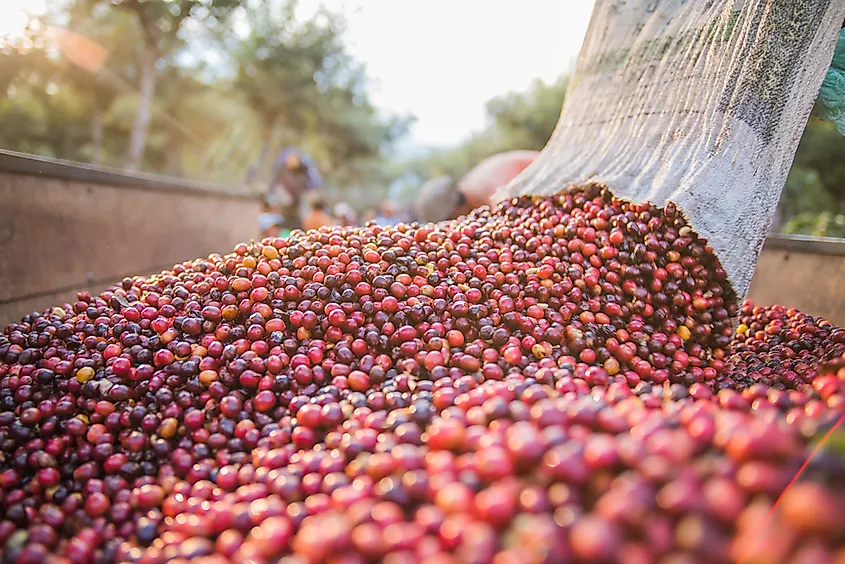
Guatemala produced 204,000 metric tons of coffee beans in 2016, and their production numbers have remained fairly consistent over the past few years. Coffee beans are most abundant in Guatemala in years where the temperature hovers between 16 and 32°C, and at altitudes between 500 and 5,000 metres above sea level. Guatemala was Central America's top producers until it was overtaken by Honduras in 2011.
Guatemala came into the coffee game predominantly to find an export to replace indigo and cochineal, two of their early exports that were rendered useless once chemical dyes were invented in the 1800s. At the time, the government began a policy of support for the industry by offering trade and tax benefits. In the 1960s the government further pushed for greater global demand for Guatemalan coffee through the establishment of Anacafé (Asociación Nacional del Café), a marketing association which, to this day, continues to promote the nation's coffee products worldwide.
9. Mexico - 234,000 metric tons (515,881,000 pounds)

In 2016, Mexico produced over 234,000 metric tons of coffee beans. The nation predominantly produces high-quality Arabica beans grown in the coastal regions near the border of Guatemala. Mexico is responsible for the majority of US coffee imports.
In the 1990s, there was a crisis in Mexico's coffee production as the International Coffee Agreement was dismantled and worldwide coffee prices and export quotas were no longer strictly controlled, leading to an inability for Mexico to compete in the global market. This decline in coffee prices and production led to lost income and social issues throughout the nation of Mexico. While coffee production declined over the 90s and into the 2000s, steady demand from the United States has led to a recovery in the Mexican coffee market, from an all-time low of 1.7 million bags (60 kg) in 2005 to 4.0 million in 2014.
8. Uganda - 288,000 metric tons (634,931,000 pounds)
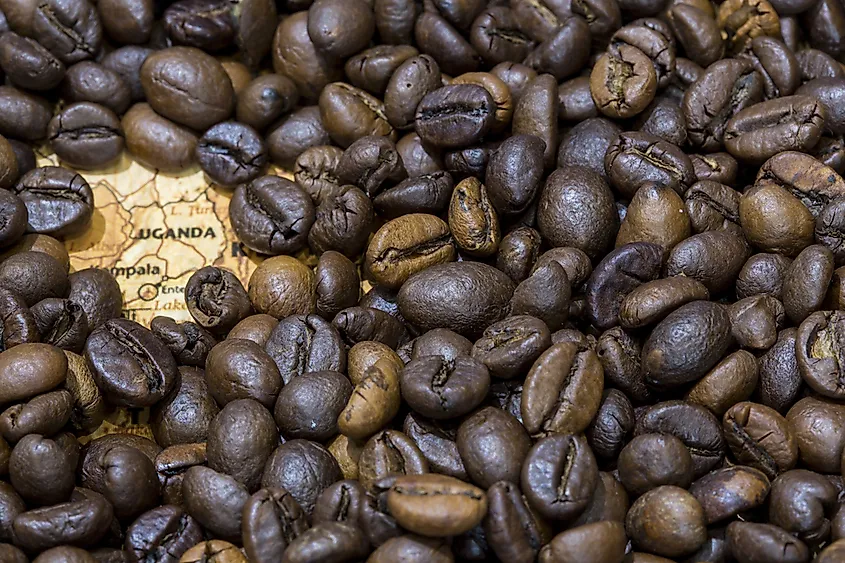
While Uganda may not come to mind when you think of coffee production, it is the Central African nation's top-earning export with 288,000 metric tons produced in 2016. It has moved past Mexico in 2015 to become the world's 8th largest producer of coffee. The nation grows both Robusta beans – a crop native to the Kibale forest area – as well as Arabica beans from nearby Ethiopia.
Coffee is a vital part of the Ugandan economy, with a large portion of the population working in coffee-related industries. Coffee production was initially a reasonably unsuccessful state-controlled sector. However, after government privatization in 1991, a strong revival of the sector was seen, leading to a 5100% increase in production since 1989. However, the government does still exert control on the industry, with flow out of the country controlled by the Uganda Coffee Development Authority.
7. India - 348,000 metric tons (767,208,000 pounds)
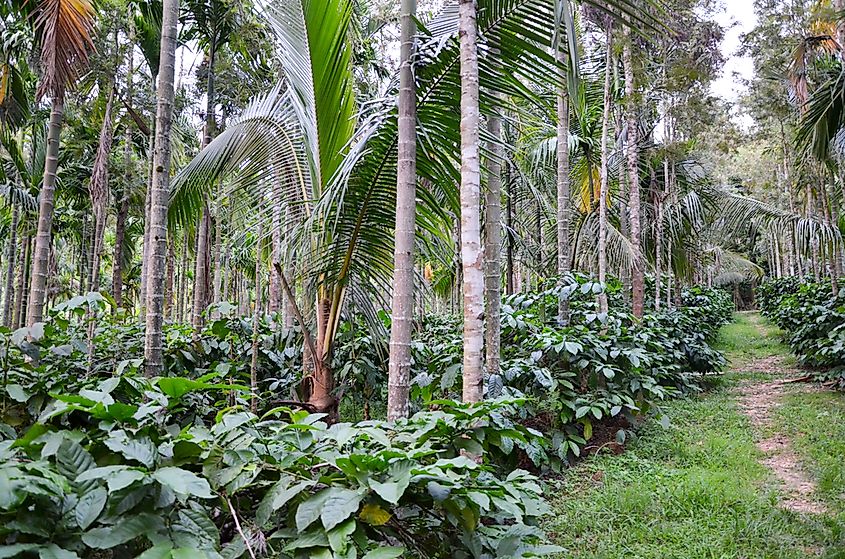
India produced 348,000 metric tons of beans in 2016. Not everywhere in India is fit for coffee bean growth - the majority of the growing is done in the hilly tracts of the southern part of the country. The beans are grown by small growers in monsoon rainfall conditions, and often planted alongside spices such as cardamom and cinnamon, which gives the coffee a spicy taste and aroma. In 2004, Indian Coffee brand Tata won three gold medals at the Grand Cus De Cafe Competition. As coffee is not nearly as popular as tea in India, 80% of the country's coffee production is bound for export purposes, with the main buyers being Europe and Russia.
6. Honduras - 348,000 metric tons (767,208,000 pounds)
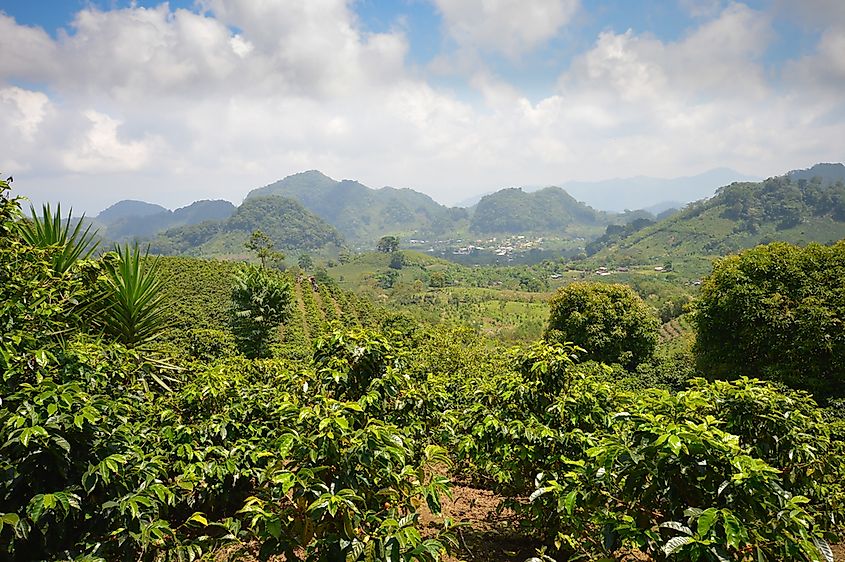
Honduras produced 348,000 metric tons of coffee in 2016, almost matching its peak crop from 2011's crop of 354,180 kilos. Honduras has outpaced other countries to become Central America's top coffee producer. However, the coffee produced in Honduras still suffers from a lack of national branding. While most people recognize Colombian or Ethiopian coffee, beans from Honduras are mainly used in blends and are therefore less recognizable to the average consumer. However, coffee remains a vital part of the Honduran economy, and the coffee industry continually provides employment and revenue for a large part of the population.
5. Ethiopia - 384,000 metric tons (846,575,000 pounds)
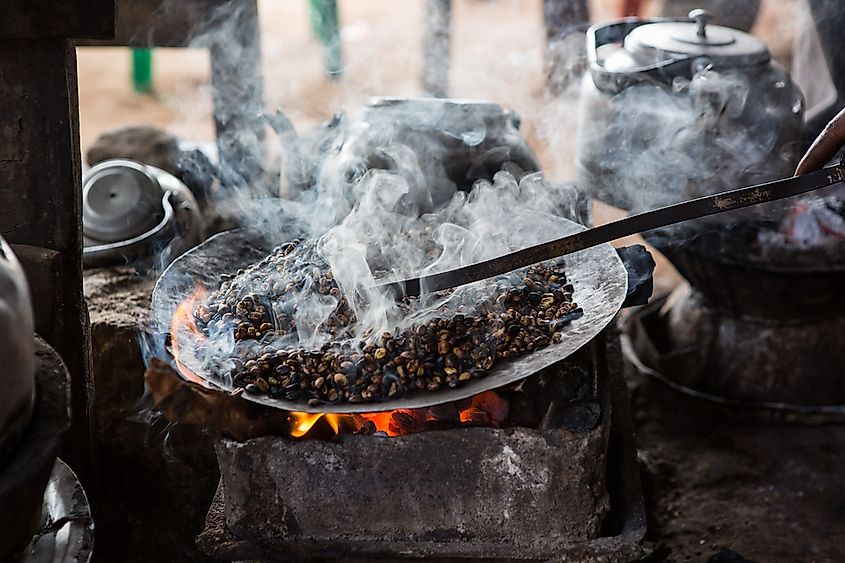
Ethiopia produces large volumes of coffee beans every year, with 384,000 metric tons in 2016 alone. Ethiopia is the geographic home of Arabica coffee, the most popular beans worldwide. It is no small part of their economy – over 28% of Ethiopia's yearly exports are a result of coffee – and it is estimated that 15 million citizens are employed in coffee production.
Ethiopia has a very rich coffee culture. For over 1,100 years, beans with a stimulating effect have been noted in the nation by unlucky farmers and shepherds whose herds happened to eat them. Since the domestication of the plant and the beginning of farming the coffee bean, regional variants of the Arabica bean have been developed, each with their own characteristic name and taste. The Harar, Limu, Sidamo, and Yirgacheffe beans are all trademarked varieties of the Arabica bean, with the rights owned and protected by the government of Ethiopia.
4. Indonesia - 660,000 metric tons (1,455,050,000 pounds)

Though they may not be as internationally known as a top producer, the nation of Indonesia produced over 660,000 metric tons of coffee beans in 2016. Indonesia has opted for a quantity over quality method, as the climate is better suited for the production of lower-quality Robusta beans (less valued than the Arabica beans that come from nations like Brazil and Colombia). However, despite this, the country has an ideal geographical location for coffee plantation, as it is near the equator and has numerous mountainous regions that are well suited for coffee production.
Coffee production was introduced to Indonesia by Dutch colonists and production continued on after colonization as Indonesia's climate is well suited for the plant. Coffee plantations currently cover over 1 million hectares of Indonesia's territory, with over 90% of the cropland being worked by small-scale producers.
3. Colombia - 810,000 metric tons (1,785,744,000 pounds)
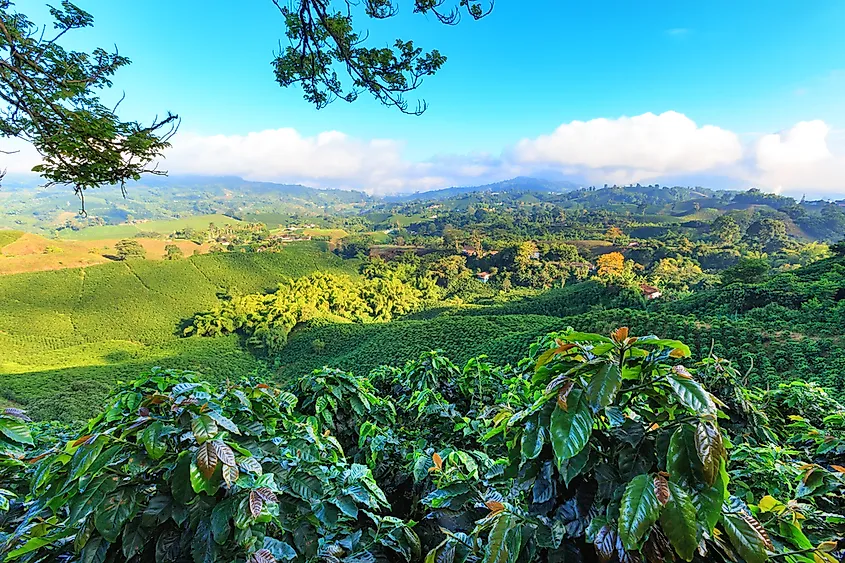
Coffee from Colombia is famous worldwide. However, the climate has recently been playing a negative role in Colombian coffee production. Between 1980 and 2010, temperatures have slowly risen, as has precipitation. Both of these factors jeopardize the climate requirements necessary to produce the type of bean favored in Colombia. It was traditionally second to Brazil for coffee production but has moved to third due to the rapidly expanding production of Vietnam. Even with the effect of climate, it has an output of 810,000 metric tons of coffee beans in 2016, Colombia remains a key player in the international coffee game.
2. Vietnam - 1,650,000 metric tons (3,637,627,000 pounds)

While many are familiar with Vietnamese coffee, a signature drink where the coffee is mixed with sweetened condensed milk, Vietnam is the second largest coffee producing nation in the world – 1,650,000 metric tons in 2016 alone. While there was understandably a hiatus during and after the Vietnam War, coffee remained a huge part of the Vietnamese economy, with the only greater export being rice. Vietnam experienced a rapid expansion in coffee production from only 6,000 tons in 1975 to almost 2 million tons in 2016. This growth has resulted in Vietnam holding on to second place on the world's most important coffee producing countries.
1. Brazil - 2,595,000 metric ton (5,714,381,000 pounds)
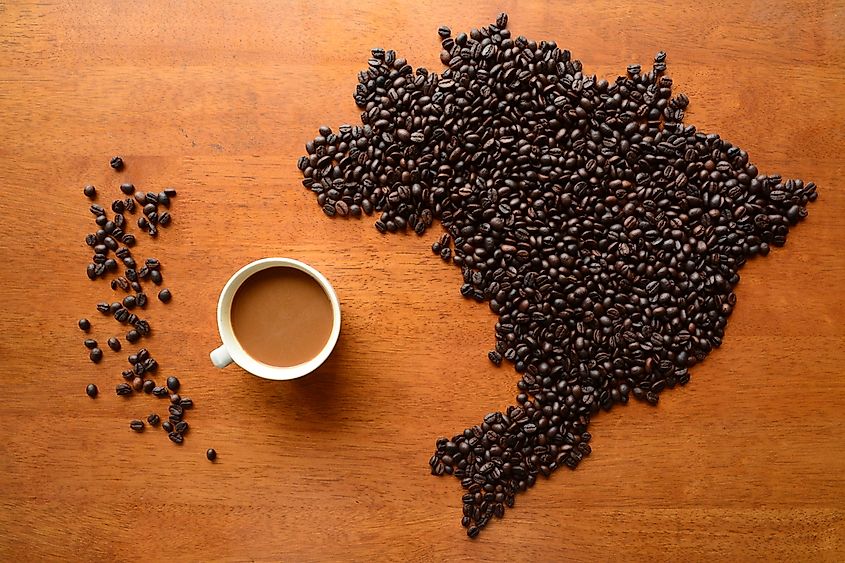
Brazil is the world's largest coffee producer. In 2016, Brazil produced a staggering 2,592,000 metric tons of coffee beans. It is not a new development, as Brazil has been the highest global producer of coffee beans for over 150 years.
Coffee plantations cover about 27,000 square kilometers of Brazil with the majority located in Minas Gerais, Sao Paulo, and Parana, three southeastern states where the climate and temperature are ideal for coffee production. Brazil also distinguishes itself from other coffee producing nations in that Brazilians process coffee using the dry process (unwashed coffee), where the coffee cherries are dried in the sun rather than washed in a wet process.
Top Coffee Producing Countries
| Rank | Country | Coffee Production (Metric Tons) | Coffee Production (Pounds) |
|---|---|---|---|
| 1 | Brazil | 2,592,000 | 5,714,381,000 |
| 2 | Vietnam | 1,650,000 | 3,637,627,000 |
| 3 | Colombia | 810,000 | 1,785,744,000 |
| 4 | Indonesia | 660,000 | 1,455,050,000 |
| 5 | Ethiopia | 384,000 | 846,575,000 |
| 6 | Honduras | 348,000 | 767,208,000 |
| 7 | India | 348,000 | 767,208,000 |
| 8 | Uganda | 288,000 | 634,931,000 |
| 9 | Mexico | 234,000 | 515,881,000 |
| 10 | Guatemala | 204,000 | 449,743,000 |
| 11 | Peru | 192,000 | 423,287,000 |
| 12 | Nicaragua | 132,000 | 291,010,000 |
| 13 | China(2013/14 est.)[2] | 116,820 | 257,544,000 |
| 14 | Ivory Coast | 108,000 | 238,099,000 |
| 15 | Costa Rica | 89,520 | 197,357,000 |
| 16 | Kenya | 49,980 | 110,187,000 |
| 17 | Papua New Guinea | 48,000 | 105,821,000 |
| 18 | Tanzania | 48,000 | 105,821,000 |
| 19 | El Salvador | 45,720 | 100,795,000 |
| 20 | Ecuador | 42,000 | 92,594,000 |
| 21 | Cameroon | 34,200 | 75,398,000 |
| 22 | Laos | 31,200 | 68,784,000 |
| 23 | Madagascar | 31,200 | 68,784,000 |
| 24 | Gabon | 30,000 | 66,138,000 |
| 25 | Thailand | 30,000 | 66,138,000 |
| 26 | Venezuela | 30,000 | 66,138,000 |
| 27 | Dominican Republic | 24,000 | 52,910,000 |
| 28 | Haiti | 21,000 | 46,297,000 |
| 29 | Democratic Republic of the Congo | 20,100 | 44,312,000 |
| 30 | Rwanda | 15,000 | 33,069,000 |
| 31 | Burundi | 12,000 | 26,455,000 |
| 32 | Philippines | 12,000 | 26,455,000 |
| 33 | Togo | 12,000 | 26,455,000 |
| 34 | Guinea | 9,600 | 21,164,000 |
| 35 | Yemen | 7,200 | 15,873,000 |
| 36 | Cuba | 6,000 | 13,227,000 |
| 37 | Panama | 6,000 | 13,227,000 |
| 38 | Bolivia | 5,400 | 11,904,000 |
| 39 | Timor Leste | 4,800 | 10,582,000 |
| 40 | Central African Republic | 3,900 | 8,598,000 |
| 41 | Nigeria | 2,400 | 5,291,000 |
| 42 | Ghana | 2,220 | 4,894,000 |
| 43 | Sierra Leone | 2,160 | 4,761,000 |
| 44 | Angola | 2,100 | 4,629,000 |
| 45 | Jamaica | 1,260 | 2,777,000 |
| 46 | Paraguay | 1,200 | 2,645,000 |
| 47 | Malawi | 960 | 2,116,000 |
| 48 | Trinidad and Tobago | 720 | 1,587,000 |
| 49 | Zimbabwe | 600 | 1,322,000 |
| 50 | Liberia | 360 | 793,000 |











